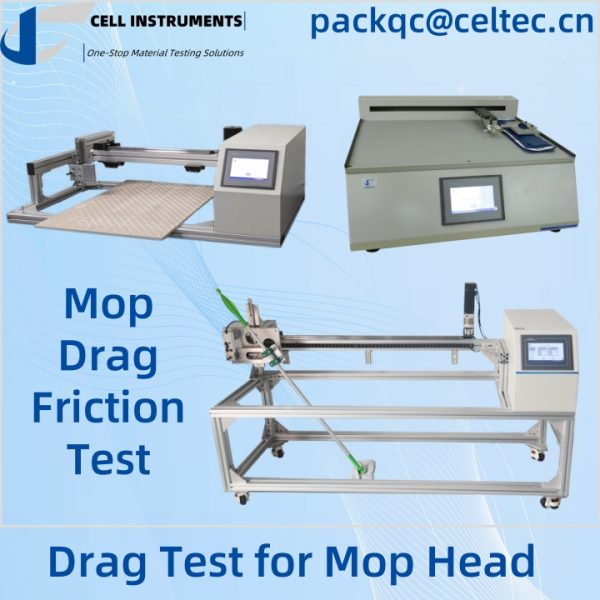Drag Test Mop Head: Ensuring Efficiency with Mop Drag Friction Testing
Drag Test Mop Head: Ensuring Efficiency with Mop Drag Friction Testing
Mop heads are essential tools in the cleaning industry, but their performance is heavily influenced by friction and drag. A drag test mop head is a critical evaluation to measure how much friction is generated when the mop is moved across different surfaces. By understanding the performance metrics, manufacturers can enhance their product design, ensuring that mop heads provide optimal cleaning with minimal effort.
The Importance of Mop Drag Friction Testing
In any cleaning operation, the balance between efficiency and thoroughness is vital. The mop drag friction test is an evaluation technique that simulates real-world cleaning scenarios. By testing the friction and resistance of mop heads against surfaces like tile, wood, or glass, companies can ensure their products meet both durability and effectiveness standards.
This test provides valuable data to manufacturers, helping to:
- Determine the level of exertion needed to operate the mop head.
- Assess the wear and tear of materials during extended cleaning tasks.
- Ensure that mops are comfortable for users, especially in industrial and commercial settings.
How Drag Testing Works
Drag testing is done using specialized equipment, such as the Mop Friction Testing Machine by Cell Instruments. Here’s a step-by-step breakdown of how it works:
- Securing the Sample: The mop head is attached to the testing apparatus.
- Engagement: The mop is placed on a test surface.
- Setting Pressure and Speed: Different pressure levels and speeds are applied to simulate real-life cleaning scenarios.
- Cycle Completion: The mop is moved in a specific pattern, and data is collected on friction and wear.
- Data Analysis: Measurements such as friction force, durability, and cleaning effectiveness are analyzed.
Why Mop Drag Friction Testing Matters
The friction between the mop head and the cleaning surface impacts not only the user’s effort but also the quality of cleaning. Too much friction can make it difficult to maneuver the mop, while too little might result in poor cleaning performance.
With mop drag friction testing, manufacturers can optimize:
- User Experience: Reduce physical strain during cleaning.
- Product Longevity: Minimize wear and tear, leading to longer-lasting mop heads.
- Cleaning Efficiency: Ensure mops pick up dirt effectively without too much friction.
Choosing the Right Equipment for Mop Drag Friction Testing
When selecting a drag testing device, features like accuracy, ease of use, and versatility are essential. Cell Instruments’ Mop Friction Testing Machine is a state-of-the-art tool that offers precise measurement of mop friction. Its PLC industrial control system and real-time data display ensure high testing accuracy, while the 7-inch HMI touch screen simplifies operation.
Applications of Mop Drag Friction Testing
Mop drag friction testing finds its applications across multiple industries:
- Home Cleaning: Testing mop heads designed for residential use.
- Industrial Cleaning: Evaluating the durability and effectiveness of mops in large facilities.
- Medical: Testing mops for sterile environments to ensure they meet hygiene standards.
Customization Options for Mop Friction Testing
Recognizing that different industries have unique requirements, Cell Instruments offers custom solutions for mop friction testing. These include:
- Software Customization: Tailored to specific testing needs.
- Fixture Customization: Designed for various mop types and materials.
Benefits of Mop Friction Testing for Manufacturers
Investing in mop drag friction testing allows manufacturers to:
- Enhance quality control: Ensuring products meet industry standards.
- Improve efficiency: Identifying weaknesses early in production.
- Innovate product development: Using precise data to create superior mop designs.
FAQ
What is a drag test for mop heads?
A drag test evaluates the friction generated between a mop head and various cleaning surfaces to measure performance and ease of use.Why is mop drag friction testing important?
It helps manufacturers understand how much effort is needed to use the mop and ensures the mop’s durability and cleaning effectiveness.How does the Mop Friction Testing Machine work?
The machine applies specific pressure and speed to a mop head to simulate cleaning, while real-time data on friction force and wear is recorded.What industries benefit from mop drag friction testing?
Industries like home cleaning, industrial cleaning, medical cleaning, and textiles benefit from optimizing cleaning tools through drag friction testing.Can the mop friction testing equipment be customized?
Yes, Cell Instruments offers software and fixture customization to meet the specific testing needs of different industries.
Related Products
Related Article
Mop Coefficient of Friction Tester

